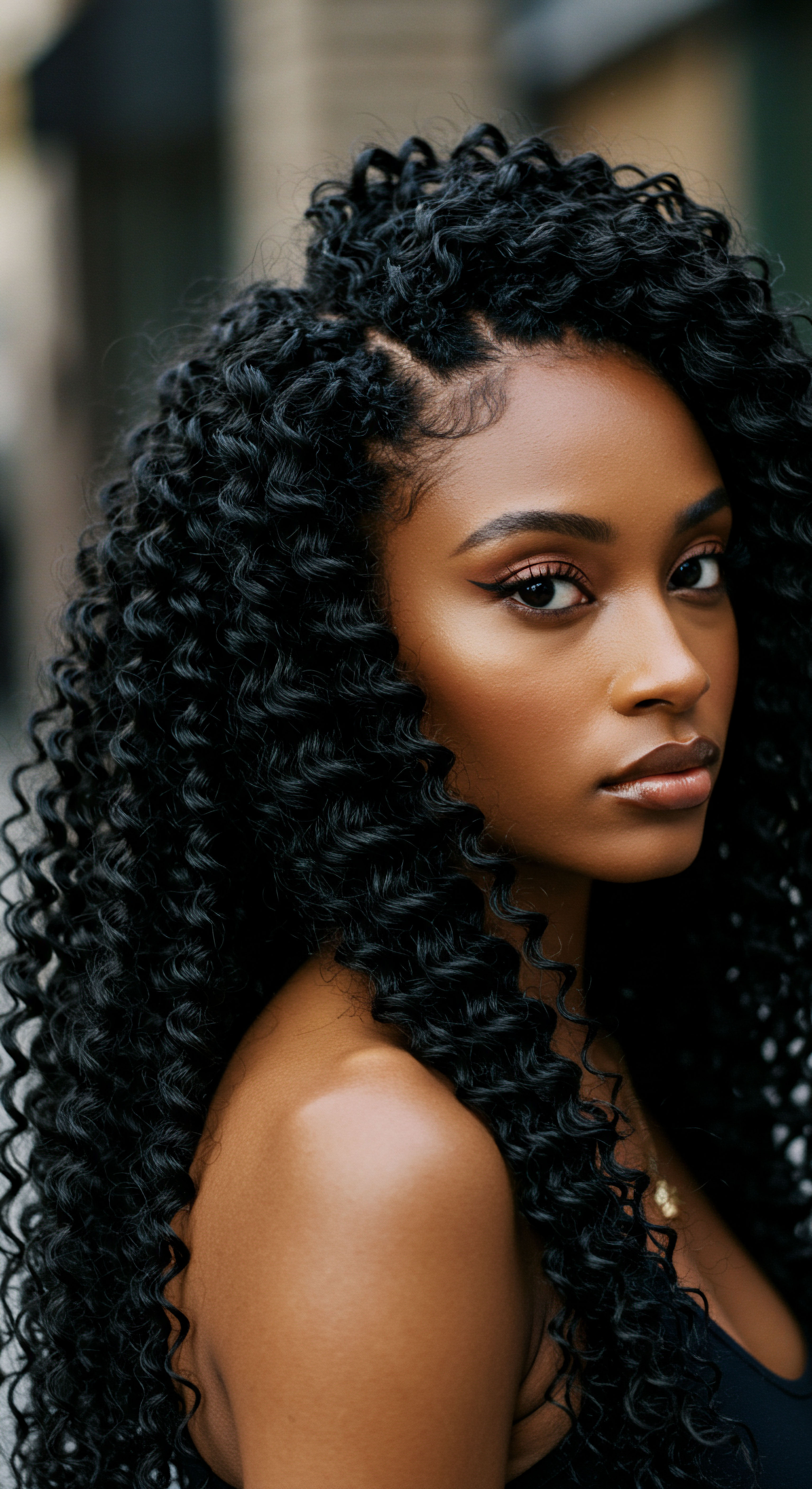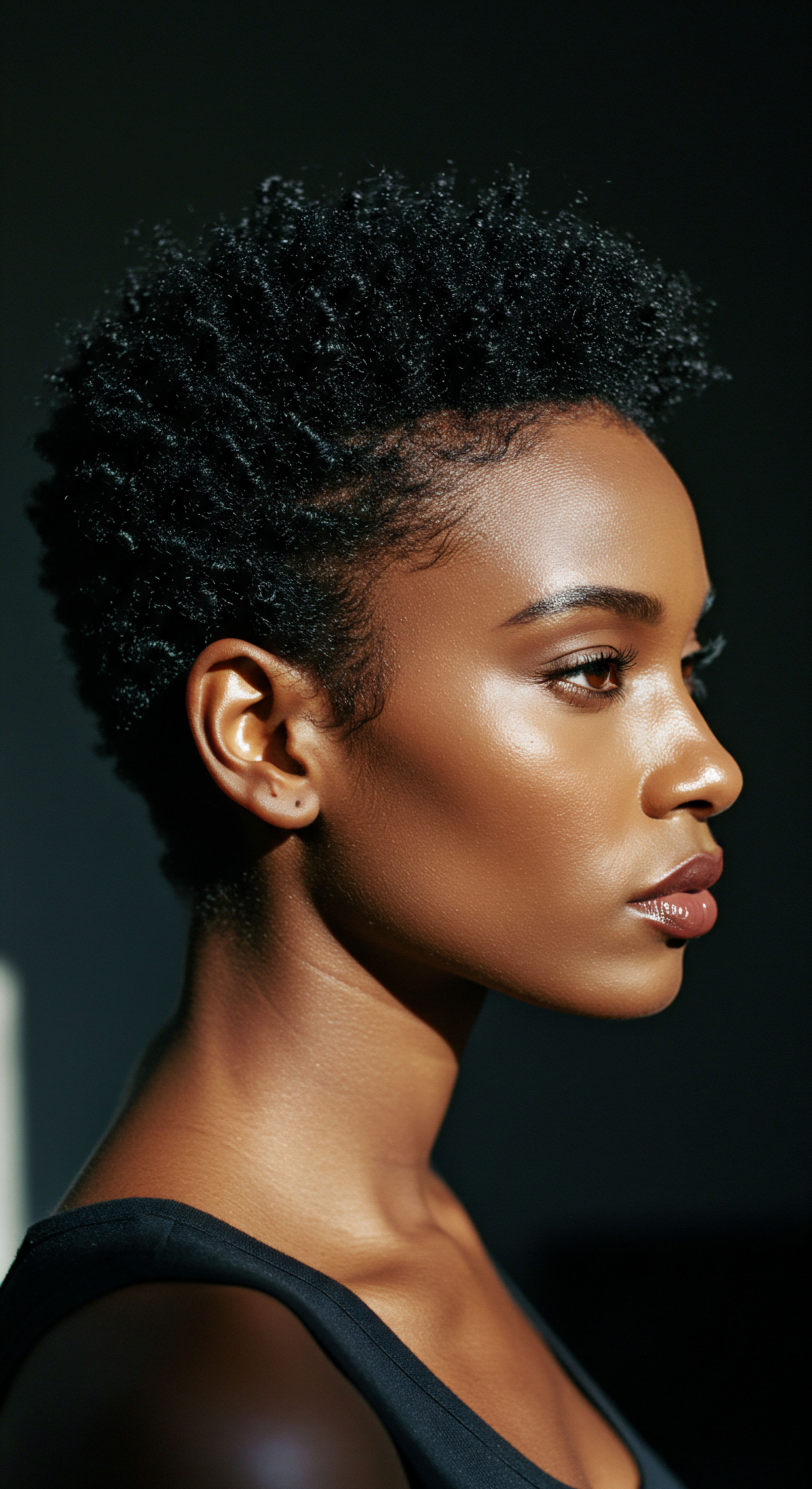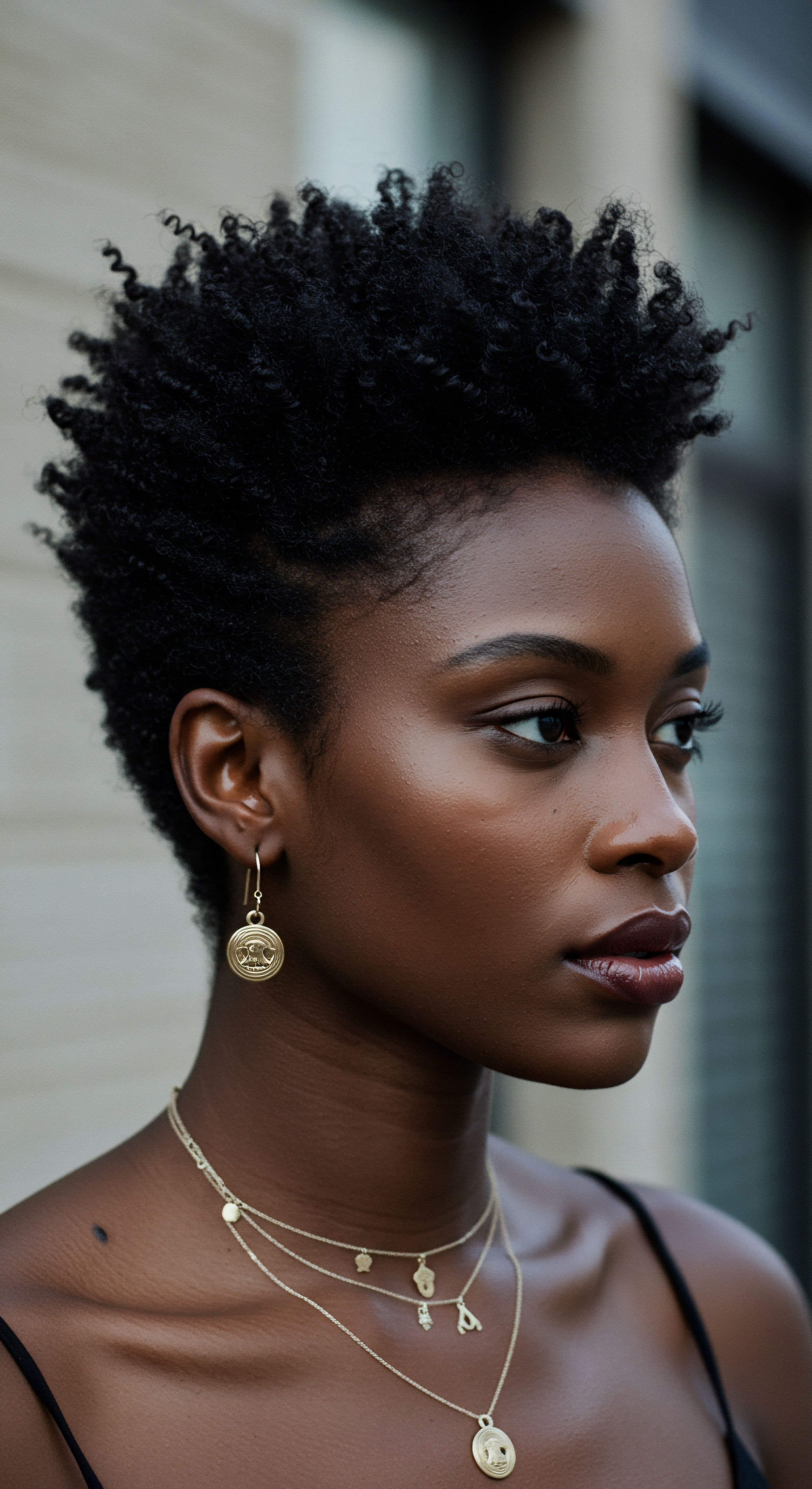
Roots
Consider for a moment the very water that graces our hair each wash day. It arrives, seemingly innocent, yet often carries a silent cargo ❉ dissolved minerals. These invisible companions, primarily calcium and magnesium ions, alter the very nature of water, transforming it from a gentle cleanser into what we know as “hard water.” For textured hair, with its unique architecture of curls, coils, and waves, this mineral presence can be particularly challenging. The hair’s natural tendency towards dryness, coupled with the varied surface of each strand, renders it more susceptible to the clinging grasp of these mineral deposits.
They can accumulate, forming a subtle film that dulls vibrancy, diminishes softness, and impedes the very moisture textured hair yearns for. Unearthing the wisdom of those who came before us reveals not just a response to this mineral challenge, but a profound understanding of the delicate balance between hair, water, and nature’s bounty.

Understanding Hard Water’s Mineral Content
Hard water is characterized by its elevated mineral content, primarily calcium and magnesium. These minerals originate from water’s journey through geological formations like limestone and chalk. When hard water comes into contact with hair, particularly during cleansing, these positively charged mineral ions, or cations, are drawn to the negatively charged areas on the hair’s cuticle.
This attraction can lead to a deposition of mineral salts onto the hair shaft and scalp. Over time, this accumulation forms a scaly film, impacting the hair’s appearance and feel.
Hard water, with its high mineral content, can coat textured hair, reducing its natural luster and moisture retention.
The degree of water hardness varies significantly by geographical region. For instance, in the United States, a substantial majority of homes, around 85%, experience hard water, indicating a widespread encounter with these mineral challenges daily. This ubiquitous presence of hard water means that its effects on hair, especially textured hair, are not isolated incidents but a common concern that spans communities and continents. The minerals bind to the hair’s surface, creating a barrier that obstructs moisture and nutrients from penetrating the hair cuticle, leading to a dry and brittle feel.

The Hair’s Vulnerability to Mineral Deposits
Textured hair, by its very design, possesses inherent characteristics that can amplify the effects of hard water. The cuticle layers, which are the outermost protective scales of the hair shaft, may lift more readily in alkaline conditions, common with hard water, allowing mineral ions to enter. This can be especially pronounced in hair that has undergone chemical treatments or sustained physical damage, as these processes create more negatively charged sites for the minerals to adhere.
A 2011 study published in the International Journal of Cosmetic Science observed that human hair, particularly chemically treated strands, can extract significant levels of calcium and magnesium from tap water. The presence of these water hardness metals inside the hair fibers was shown to induce fiber stiffening, which can lead to reduced flexibility and increased friction, contributing to breakage and tangles.
Furthermore, the natural curl patterns of textured hair mean that oils and moisture take longer to travel down the hair shaft, leaving the ends more prone to dryness. When mineral deposits add to this challenge, the hair can become even more resistant to hydration, feeling rough, looking dull, and lacking its characteristic spring and movement. Scalp irritation is another common symptom, with mineral buildup potentially clogging follicles, leading to itchiness, flaking, or conditions resembling dandruff.

Ritual
Stepping into the realm of practical wisdom, we seek to understand how our forebears approached the daily or periodic challenges presented by water. Their solutions were not merely reactive fixes, but deeply integrated practices that respected the interplay of natural elements and the inherent qualities of hair. These were rituals born from observation, passed down through generations, each movement and ingredient chosen with an intuitive understanding of hair’s needs. We can learn much from their gentle guidance, moving beyond simple methods to embrace a more holistic perspective on hair care.

Harnessing Acidity to Counteract Mineral Buildup
One of the most widespread and enduring ancestral strategies to combat the effects of hard water involved the judicious use of acidic rinses. This practice, observed across diverse cultures, served to neutralize the alkaline nature of hard water and to dissolve the mineral deposits that clung to hair strands. The underlying scientific principle here is the reaction between acids and the alkaline mineral salts, primarily calcium carbonate, that comprise hard water deposits. Acids help to break down these salts, allowing them to be rinsed away more easily.
A prominent example of this is the application of Vinegar Rinses. Ancient Greeks and Romans, for instance, were known to use vinegar to cleanse their hair. This tradition persists in various forms globally, with apple cider vinegar (ACV) being a popular choice today.
A diluted mixture of apple cider vinegar with water helps restore the scalp’s pH balance and removes mineral accumulation. While daily use might lead to dryness, a weekly application can significantly improve hair’s softness and shine.
Similarly, Citrus Juices, such as lemon or lime, provided another accessible source of acidity. Egyptians used citrus juice and water for hair cleansing. These fruits contain citric acid, a natural chelating agent, which can bind to mineral ions, preventing their deposition or helping to remove existing buildup. A simple rinse of lemon or lime juice mixed with water could address oily hair and mineral residue.
Consider the PH Scale, a fundamental concept in hair science. Hair itself has a slightly acidic pH, typically ranging from 4.5 to 5.5. Hard water, often with a higher pH, can cause the hair cuticle to lift, leaving strands vulnerable.
Acidic rinses, when properly diluted, help to smooth the cuticle back down, sealing in moisture and promoting shine. Research indicates that maintaining hair within a pH range of 4.5 to 7 is optimal, as exposures outside this range can make hair more susceptible to damage and alter its protein structure.
| Source Apple Cider Vinegar |
| Primary Acid Acetic Acid |
| Mechanism of Action Dissolves calcium carbonate, balances pH, smooths cuticle. |
| Cultural Context Widely used across many cultures, persists in modern natural hair care. |
| Source Lemon/Lime Juice |
| Primary Acid Citric Acid |
| Mechanism of Action Chelates minerals, brightens, helps with oiliness. |
| Cultural Context Ancient Egyptian hair cleansing practices. |
| Source Fermented Rice Water |
| Primary Acid Lactic Acid, Amino Acids |
| Mechanism of Action Conditions, adds shine, strengthens hair structure. |
| Cultural Context Red Yao women of China, traditional Asian hair care. |

Cleansing with Earth and Plant Extracts
Beyond acidic rinses, ancestral communities turned to the earth itself and the plant kingdom for cleansing agents that could contend with hard water’s effects. These natural materials often possessed properties that allowed them to cleanse without stripping the hair, and in some cases, even bind to the offending minerals.

Clay Washes
Clays, particularly those rich in minerals like rhassoul and bentonite, have been used for centuries as cleansing agents. Rhassoul Clay, a mineral-rich Moroccan volcanic clay, was historically used for washing hair, face, and body. Its name itself, derived from the Arabic word “ghassala,” means “to wash.” Rhassoul clay contains negatively charged molecules, allowing it to attract and bind to positively charged impurities, including dirt, oils, and potentially some mineral deposits, effectively detoxifying the scalp and hair without removing its protective sebum layer. This gentle yet effective cleansing action was particularly beneficial in regions with hard water, as it helped remove buildup without exacerbating dryness.

Saponin-Rich Plants
Certain plants contain natural saponins, compounds that create a mild, soapy lather when mixed with water. These natural surfactants offered a cleansing alternative that was often less reactive with hard water minerals than traditional lye soaps.
- Shikakai (Acacia concinna) and Reetha (Indian soapberry) have a long history in Ayurvedic hair care as natural cleansers and conditioners. These Indian herbs are particularly effective in hard water because they contain biological chelating agents that assist in removing mineral buildup. They not only cleanse but also contribute to hair’s body and luster, leaving it feeling softer.
- Yucca Root, used by Native American tribes, is another example of a saponin-rich plant. Crushed and mixed with water, it forms a soapy lather, providing a natural shampoo that cleanses and nourishes the hair.
- In the Andes, Pre-Columbian civilizations utilized saponin-rich water remaining after rinsing quinoa to cleanse their hair. This resourcefulness highlights a deep connection to available natural resources for hair care.

Rainwater Collection
Perhaps the most straightforward ancestral practice to circumvent hard water’s challenges was simply to avoid it altogether by collecting and utilizing naturally soft rainwater. This method has been practiced for thousands of years across various civilizations, including in India, Mesopotamia, China, and ancient Israel. Early settlers in the 16th-17th centuries in North America specifically collected rainwater for laundry due to its softness, recognizing the difficulties associated with washing in mineral-rich water.
The collection systems varied in sophistication, from simple large buckets placed outside during rainfall to elaborate cisterns built by the Romans, which could hold millions of gallons of water for bathing, washing, and other domestic uses. The very distinction between “hard water” and “soft water” emerged from the observed difficulties of using mineral-rich water for washing compared to the ease of using rainwater, which allowed soap and dirt to rinse away cleanly. This practice directly addressed the problem at its source, providing a gentle, mineral-free alternative for hair cleansing.

Relay
To truly comprehend the depth of ancestral hair practices, we must transcend a mere listing of methods and consider the intricate interplay of environmental conditions, cultural values, and scientific understanding, however nascent. How did these seemingly simple remedies achieve their profound effects on textured hair, often in environments where water was a constant challenge? This section seeks to peel back the layers, revealing the complex rationale and subtle mechanisms that underpinned these ancient traditions, drawing upon modern research to illuminate their enduring wisdom.

The Biophysical Response of Textured Hair to Minerals
Textured hair possesses a unique cuticle structure, often with more lifted scales, particularly at the curves of coils and curls. This structural characteristic, while contributing to its beauty, also renders it more susceptible to mineral deposition from hard water. The positively charged calcium and magnesium ions present in hard water are readily attracted to the negatively charged sites on the hair’s cuticle. This adherence creates a mineral coating that can disrupt the hair’s natural moisture balance and flexibility.
A significant study in the Journal of Cosmetic Science in 2019 revealed that hard water significantly increases hair roughness and decreases tensile strength, leading to more breakage. This physical alteration makes textured hair, already prone to dryness and fragility, even more vulnerable. Furthermore, a 2020 study from the same journal indicated that hair washed with hard water experienced a 25% reduction in moisture compared to hair washed with soft water. This profound impact on moisture retention directly correlates with the dry, brittle feel often associated with hard water exposure on textured strands.
The cumulative effect of mineral buildup is a gradual loss of hair’s natural spring and softness. It can hinder the effectiveness of conditioning products, as the mineral film creates a barrier that prevents nourishing ingredients from reaching the hair shaft. This leads to a vicious cycle where hard water exacerbates dryness, and dry hair, with its raised cuticles, becomes even more prone to mineral uptake.
| Mineral Type Calcium |
| Primary Effect on Hair Coats hair, causes stiffness and dryness. |
| Observed Symptoms Heavy feel, dullness, flakiness on scalp. |
| Mineral Type Magnesium |
| Primary Effect on Hair Combines with other problems, affects curl pattern. |
| Observed Symptoms Curls drop, dryness, reduced shine. |
| Mineral Type Iron |
| Primary Effect on Hair Leads to brittleness and dryness. |
| Observed Symptoms Brittle hair, split ends, discoloration. |
| Mineral Type These minerals can lead to a film on hair, reducing light reflection and making hair appear dull. |

Beyond Cleansing The Role of PH and Chelation
Ancestral practices often intuitively manipulated water chemistry without formal scientific language. The use of acidic rinses, for example, directly addresses the pH imbalance caused by hard water. Hard water typically has a higher pH, which can cause the hair cuticle to swell and lift. This makes the hair more porous and vulnerable to damage, as well as more receptive to mineral deposition.
Applying an acidic rinse, such as diluted vinegar or citrus juice, lowers the pH of the hair and scalp environment, causing the cuticle to lie flat. This action not only smooths the hair, enhancing shine and reducing tangles, but also physically dislodges some of the mineral deposits.
Ancestral hair care, though not termed ‘science,’ often demonstrated a deep, intuitive grasp of hair’s needs and its interaction with environmental elements.
Furthermore, certain plants utilized ancestrally contain natural chelating agents. Chelation is a chemical process where a substance forms a soluble complex with metal ions, effectively “grabbing” them and preventing them from reacting with other substances or depositing on surfaces. Shikakai and reetha, for instance, are noted for their biological chelating properties, which enable them to remove mineral buildup from hair.
This means they weren’t just cleaning the hair; they were actively working to neutralize the hard water’s detrimental effects on a chemical level. This is a subtle yet profound scientific insight embedded within ancient traditions.
The impact of chelating agents is significant for textured hair. When minerals are chelated, the hair’s surface becomes cleaner and smoother, allowing for better penetration of moisturizing and conditioning products. This can dramatically improve hair’s softness, manageability, and overall health, reversing the dryness and brittleness often associated with hard water.

The Cultural Context of Water Sourcing and Hair Health
The choice of water for hair care was not merely a matter of convenience; it was often deeply intertwined with cultural practices, environmental conditions, and an understanding of water’s properties. In regions where naturally soft water was scarce, communities developed sophisticated methods for water collection and treatment.
For example, the widespread practice of Rainwater Harvesting, documented in civilizations from ancient India to Rome, highlights a clear preference for softer water for washing. The Romans, renowned for their engineering, constructed vast cisterns to collect rainwater for various domestic uses, including bathing. This was not just about water availability for consumption, but also about recognizing the qualitative difference rainwater offered for personal hygiene. The naturally soft nature of rainwater meant that soaps lathered more effectively and rinsed away cleanly, preventing the residue that hard water caused.
This cultural understanding of water quality extended to the development of specific rituals around water sourcing. In some African tribes, the collection of rainwater or water from specific natural springs known for their softness might have been part of hair care rituals, underscoring a deep connection between the environment and personal wellbeing. While direct research on African diaspora hair practices specifically addressing hard water is limited, the general emphasis on natural ingredients and moisturizing oils suggests an intuitive response to environmental stressors, including water quality. The use of shea butter, for example, could serve as a protective barrier against harsh water conditions, helping to seal in moisture and reduce the adherence of minerals.
The continuity of these practices, from ancient times to their modern adaptations, underscores their effectiveness. They offer a powerful reminder that true hair wellness begins with a deep understanding of the environment and a respectful approach to natural resources, echoing the Roothea philosophy of gentle, informed care.

Reflection
As we close this exploration into ancestral responses to hard water’s effects on textured hair, a quiet wisdom lingers. The journey through ancient practices reveals a profound connection to the earth, a deep observation of natural phenomena, and an intuitive understanding of hair’s delicate needs. Our forebears, without the benefit of modern chemistry labs, discerned the subtle shifts water caused and crafted solutions that stand the test of time.
They remind us that true hair care transcends fleeting trends, finding its enduring strength in simplicity, natural elements, and a reverence for heritage. The legacy they offer is a gentle invitation to listen more closely to our hair, to the water that nourishes it, and to the enduring whispers of the past.

References
- Evans, A. O. Marsh, J. M. & Wickett, R. R. (2011). The structural implications of water hardness metal uptake by human hair. International Journal of Cosmetic Science, 33(5), 421-427.
- Luqman, M. W. Ramzan, M. H. Javaid, U. Ali, R. Shoaib, M. & Luqman, M. A. (2018). To Evaluate and Compare Changes in Baseline Strength of Hairs after Treating them with Deionized Water and Hard Water and its Role in Hair Breakage. Journal of Hair Science.
- Angelakis, A. N. (2016). History of Water Supply in Ancient Greece and Rome. IWA Publishing.
- Ghasemi, P. Sadeghi, S. & Ghasemi, S. (2017). Ethnopharmacological survey of home remedies used for treatment of hair and scalp and their methods of preparation in the West Bank-Palestine. BMC Complementary and Alternative Medicine, 17(1), 339.
- Wendy, M. S. (2013). pH of Common Homemade Rinses. Science-y Hair Blog.
- Bakhshi, S. & Bakhshi, M. (2016). Scanning electron microscopy of hair treated in hard water. Indian Journal of Dermatology, 61(4), 450.
- Ahuja, M. & Kumar, A. (2019). The Role of Natural Ingredients in Hair Care ❉ A Review. Journal of Cosmetology and Trichology, 5(1), 1000130.
- Chauhan, M. & Sharma, P. (2020). Hair Damage from Hard Water ❉ A Review of Solutions. Journal of Cosmetic Science, 71(4), 221-228.
- Angelakis, A. N. & Spyridakis, A. (2010). Water Management in Minoan Crete. Water Science & Technology Water Supply, 10(2), 290-297.
- Verma, S. & Singh, R. (2021). Natural Hair Colour – Pigmentation. The Trichological Society.
- Dhar, A. (2022). Ayurvedic Hair Care ❉ Ancient Wisdom for Modern Hair Problems. DK Publishing.
- Mohamed, R. A. & Abdul Razak, A. R. (2023). The Legacy of Lathers ❉ Tracing the Historical Use of Natural Ingredients in Hair Cleansing. Journal of Traditional Medicine & Clinical Naturopathy, 12(3), 321.
- Al-Snafi, A. E. (2015). The Medical Benefit of Rhassoul Clay. Journal of Pharmaceutical Biology, 5(1), 1-5.
- Wester, R. C. & Maibach, H. I. (2005). Percutaneous Absorption of Chemicals. Taylor & Francis.